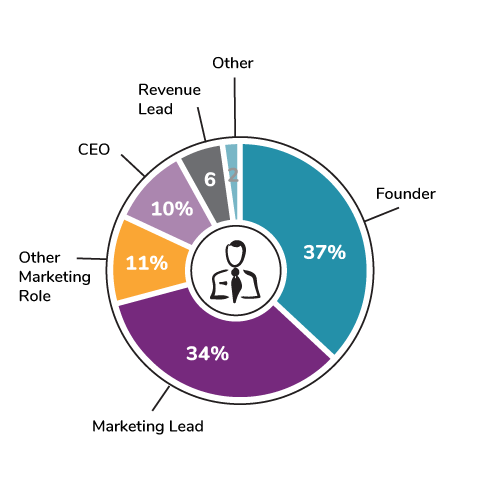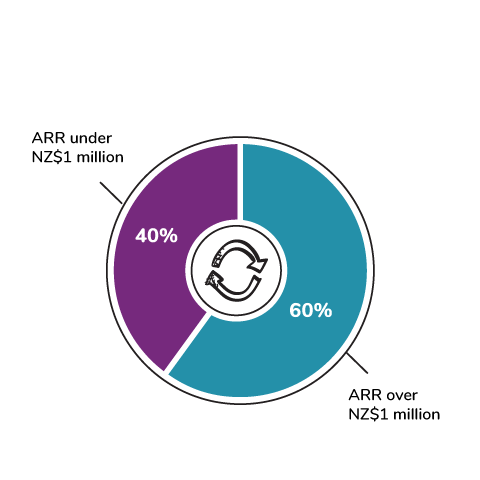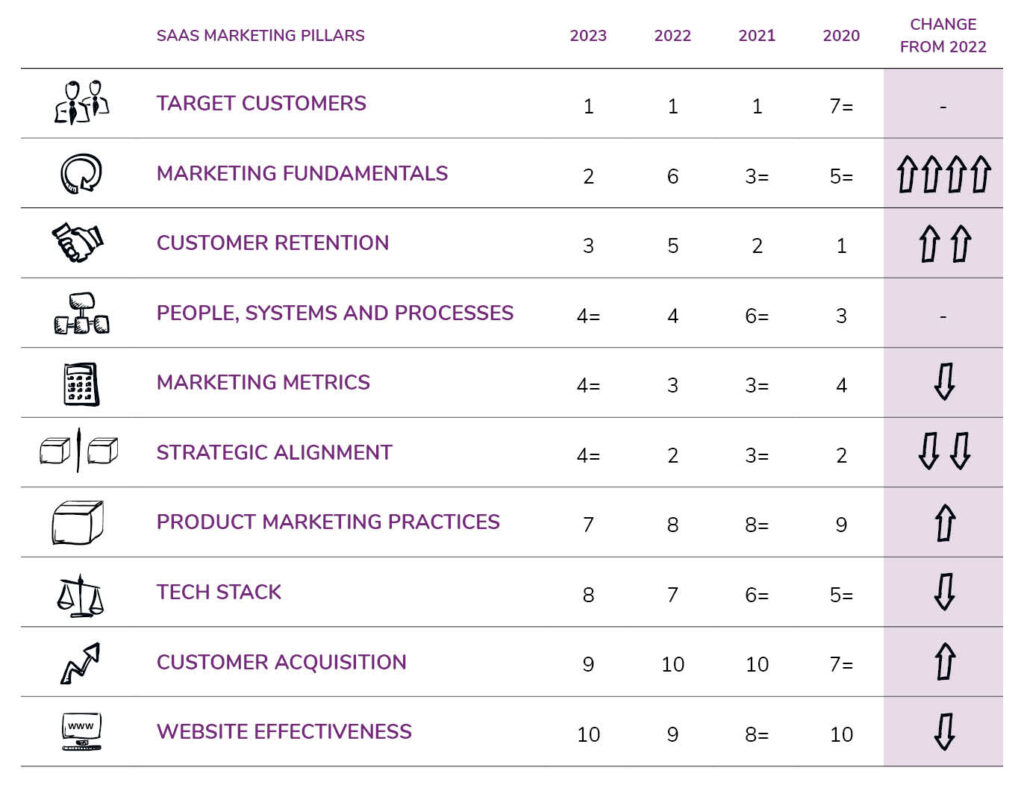Welcome to the fourth edition of Proxi’s SaaS Marketing Capability Report, which brings together the findings and insights from a survey conducted amongst over 70 Kiwi SaaS businesses in Spring 2023.
It’s been a fascinating year, with SaaS continuing to grow and mature as a business model in New Zealand. It’s clear that our nation remains extremely well placed to capitalise on the trend as our understanding of the model improves and it’s great to see the government getting behind the trend with investment and support for the sector.
The survey delivered some interesting insights and shines a light on a number of areas where the industry continues to struggle – shown not only in this year’s results, but also based on data we’ve collected over the past four years. Rather than provide a high level narrative across all the areas of the survey as we’ve done in previous years, this year we’ve taken a really deep dive into three areas where Kiwi SaaS businesses appear to be struggling most; website effectiveness, customer acquisition and product marketing.
Best wishes
The Proxi Team
We spoke to a mix of NZ SaaS businesses, including Self-Service and Account-Sales SaaS, with various funding models, growth stages and geographies.
This year, we had the largest response, with a higher proportion of founders and CEOs (47% vs 31% in 2022) participating in the survey. In fact, more senior leaders are interested in marketing, with 53% of respondents having senior roles in 2023, excluding marketing leaders (vs 33% in 2022). Is this an indication of a movement to more marketing-led organisations?






Businesses rated their capability on 10 strategic marketing pillars using a six-point scale, where one is poor and six is awesome. We’ve ranked the pillars based on the proportion of businesses rating themselves as a five or six (top two-boxes), indicating they think they’ve pretty much got that pillar nailed.

From an overall perspective, the popularity of the survey continues to grow. We had 16% more survey responses than last year and those responses came from a more senior audience, which we see as positive. It shows more senior execs recognising the importance of marketing capability inside their organisations.
With more senior engagement in marketing, we can also assume a subtle shift towards businesses becoming more marketing-led, which is extremely important if the sector is to continue to thrive. If everyone inside an organisation (starting from the CEO) has a deep understanding of the customer, their needs and their problems, then the quality and value of the businesses New Zealand produces can only improve.
The broad picture that emerged in earlier reports can be seen in this year’s edition.
Kiwi companies are getting better at understanding their target customers, with that particular pillar seeing a significant improvement over last year (57% rating themselves good or very good relative to 47% in 2022). This marketing pillar ranks #1 for the third year running.
The marketing fundamentals pillar – which explores the concepts of purpose, mission, vision and values – rose significantly – and has risen consistently over the last four years from just 28% in 2020. Another positive showing that businesses are becoming more self-aware and purpose-driven.
Other notable insights:-
At the other end of the scale, the bottom four pillars remain the same as last year – product marketing, marketing tech stack, customer acquisition and website effectiveness.
These are important issues and lie at the heart of SaaS growth. And digging deeper into the data, it’s clear that organisations with sub $1m ARR are finding these capabilities particularly challenging.
1: We’re still trying to figure out who our target customer really is.

6: Intimately. We know exactly who they are, where they are and how to engage with them.
1: Not much, if anything, is written down – we’re essentially making it up as we go along.

6: Everyone in the business knows who we are selling to and the experience they should go through.
1: We don’t. We hope they stay, but we really don’t do anything to keep them or understand why they leave.

6: We have a programme to stay in touch that keeps them informed, spending more and advocating for us.
1: No one is really responsible for marketing – there’s no clear plan or budget and our systems and data are all over the place.

6: Marketing responsibilities are well defined and managed with a clear plan, budget and reporting with solid systems in place.
1: We don’t. We need to get a handle on our KPIs, but don’t know where to start.

6: We have a comprehensive KPI dashboard that’s updated weekly. Our business is run by the insights we derive from them.
1: Our company strategy itself isn’t clear and our marketing activities are scattergun.

6: In perfect sync; company strategic decisions are made in consultation with our marketing lead.
1: We make it up as we go along, chasing deals and shaping the roadmap/product on what we think customers want.

6: We listen deeply to what our customers and the market wants, staying in sync with well-defined roadmaps and processes.
The maturity of SaaS companies’ product marketing practices came in at seventh on the list. Although not among the lowest, we’ve decided to focus on this pillar as it typically scores very low in our annual surveys.
Product marketing is a specialisation within marketing. That’s right, product marketing requires a unique set of skills, knowledge and expertise that general marketers (often) don’t have and all SaaS businesses need. NZ is a small market with very few experienced product marketers, so you are unlikely to have the right skills within your business.
Product marketing is where the rubber hits the road for SaaS companies. It’s the glue between sales, marketing, customer success and product, the function responsible to drive demand for your product, and ultimately drive adoption, retention and expansion. And if these four critical functions in your business don’t align, your business can appear schizophrenic, which is not good.
To understand how schizophrenic your business might appear, ask a few people around your organisation: ‘Who are our ideal customers?’ and ‘Why should they buy our product or service?’
If the answers you get are not substantially similar or take more than 20 seconds to articulate, you need to get clarity on your product story quickly. And you must then ensure your Sales, Marketing, Customer Success and Product teams are aligned around this story, also known as a value proposition.
There are several steps that will help you develop your value proposition: –
This is the only place to start. Clarifying this will help the rest of the process and make identifying competitors easier.
Hint: competitors are not always obvious; there are other things the customer might do to resolve their problem.
Why does our product exist?
Your product will exist to solve a significant problem for a set of customers. The problem must be substantial enough to cause the customer to want to solve it. If not, you don’t have a business.
Articulate who these people are and what their problem is. Stay away from personas, who’s the decision maker, or what user types you might have. If you’re having these discussions now, you’re in the weeds.
Why does our product matter?
Your product doesn’t matter because of the features it offers users. Your product will matter because of the benefits it delivers to consumers.
Here’s where you get to decide on what is the single most important benefit your product delivers.
Hint: remember your customers have emotions and aspirations for themselves, their families and those around them. These emotional and aspirational benefits will move prospects to action quickly and more often than your product’s function benefits.
What sets our product apart from our competition?
When prospects make a purchase decision, they will weigh up several factors, either consciously or subconsciously. There are probably two or three, but never more than five. The key to meaningful differentiation is discovering these factors, how you rate compared to your competitors and ensuring your product is better than the competition in at least one of the most influential factors.
Now, you should know why your product is truly meaningful in the lives of our customers!
For <target customers> who need <statement>, the <product/brand name> is a <product category> that <key benefit statement/compelling reason to buy>.
<Product name> excels at <key difference between our product and our competition>, <that is meaningful to our target>.
Now is the time to test your value proposition and see if it resonates. If not, understand why and change it until it does.
Once you’ve nailed your value proposition, you can focus your product marketing efforts on driving adoption, retention and expansion by taking features to market (internally coordinating), defining key communication channels, and enabling Sales and Customer Success teams.
We asked Triona Saunders, Chief Marketing Officer at Actionstep for her view on the role of product marketing and what difference it can make to the success of a business. Her summary below makes a lot of business sense.

“It can be a challenge finding great product marketers in New Zealand, so there’s a certain mystique about what it really is. However, product marketers can be successfully nurtured from brand and content marketing talent – particularly pattern seekers with lots of curiosity – creating discipline through frameworks and internal communication to support go to market.
Building a product marketing discipline at your business can be a real catalyst in legitimately tying product development into your overall brand and value proposition. It helps bring the strategy to life and form a hub for go to market teams so that everyone is informed and ready to drive product/functionality adoption.”

1: We use a free CRM and Google Analytics. What else do we need?

6: We have a fully integrated tech stack, providing a 360 degree view of our customers across all channels, from first touchpoint to product usage.
1: It’s a bit hopeless; we jump from one thing to the next and don’t learn as we go. We are spraying and praying – it’s really not working.

6: We’ve got a well-oiled acquisition machine that turns over customers at the right cost. We know what works, what doesn’t and why.
Customer acquisition, at its simplest level, is the result of deep alignment between marketing and sales. From the top to the bottom of the funnel, from customer identification and targeting through to deal closed. For customer acquisition to work, marketing and sales have to be in absolute lock-step (and they rarely are, which is a useful insight to start with).
What your go-to-market model should be is intricately associated with the size of the market, your Annual Contract Value (ACV) and whether people are actively trying to solve the problem your software solves.
How you see customer acquisition somewhat depends a lot on your go-to-market model. If you’re pure self-service, then your website and your product are your acquisition engine. On the other end of the spectrum, if you sell high-end enterprise SaaS, your website will likely be a brochure and your team of highly paid sales execs are your sales engine. And there is, of course, every shade of grey in between!
When we say ‘customer acquisition could be better’, what we’re saying is ‘we’re not selling enough’. Unpicking that statement requires us to go over the funnel to figure out where it’s breaking down – because customer acquisition is ALL of the funnel, not just the bottom bit.
The first questions to ask are do we have a funnel? and do we understand it? Because if you don’t, you’ve found your first problem. SaaS businesses live and die by their funnel, and they are crucial. If you haven’t got one, then get one!
Assuming you’ve got a funnel, and you’re operating the widely common sales-assisted model, let’s start by oversimplifying things significantly and split the funnel into marketing (top of the funnel) and sales (bottom of the funnel) with a hand-off somewhere in the middle with a Sales-Accepted Lead (SAL) provided by marketing to sales.
Part of Marketing’s job is to find leads for sales to close. For marketing to do their job, they’ve got to get a long laundry list of things right, including brand positioning, website, pricing and product marketing. If that stuff is wrong, customer acquisition will be off.
And remember, of course, that they’ve got to be marketing something that people want. If the business sells something for which there’s no market, it doesn’t matter how good or smart the marketing team is; it will fail, and the customer acquisition engine will fail.
Assuming there’s a market, what marketing SHOULD be doing is relatively well-understood. Sure, they can execute it poorly, but they shouldn’t.
The sales stage (where a person interacts with a prospect) is an interesting phase and arguably the least well-understood part of the funnel.
The first thing you’ve got to get right is the metrics. Putting field salespeople on the road for a $5k deal is instant death to the business. It’s just not economical, unless there is a tremendous expansion opportunity on the back of this initial $5k deal. If you can’t close this deal without visiting the customer in person, there’s a good chance you don’t have a viable business model and need to have a serious look at your positioning, pricing, product, etc.
Your ISRs can be anywhere in the world. However, your FSRs MUST be in-market, ideally from the industry and very well trained on your product – which is super hard to nail when they’re on their own and a long way from their home base. Hire two. Build a team. Get the CEO in to the market to support them as soon as physically possible.
Alex McNaughten, Founder and Rev Ops Coach at Sales Leaders has helped over 130 B2B businesses and hundreds of sales professionals scale their revenue function and build predictable sales results. He believes that the Kiwi ecosystem needs to level up it’s sales capability if it is to compete internationally and shared the following facts with us – which may well explain why so many businesses struggle to nail the sale…

“95% of sales leaders have no sales leadership training and 75% of sales people have had no sales training – makes us wonder why the average quota attainment is 39%.”
“Most sales team performance problems, particularly in startups are rooted in weak sales processes, poor sales leadership and/or inadequate training.”
“mid-funnel sales processes are under-developed in most Kiwi startups / growth companies. This leads to huge revenue leakage.”

The more interesting conversation here is about the salesperson and the sales model.
Good salespeople – people who see sales as an honourable profession – are few and far between. There are plenty of people who masquerade as salespeople but in reality are just order-takers.
If acquisition is underperforming look at the whole funnel – not just marketing, not just sales. Work out where it’s broken by analysing funnel metrics over time and finding the places where it’s falling over. Run a change programme to test and tweak different aspects of the funnel. Don’t throw the baby out with the bathwater. Look hard at the sales model and focus on getting it right in the long-term, because there is no short term (in enterprise selling at least).
1: I’d like to change just about everything on it. I’m not sure it’s helping us at all. It’s not optimised and I can’t tell you how well it ranks in Google search.

6: Near perfect; it tells the right story, converts customers effectively. It ranks one in Google search against our key words.
For the second year in a row, website effectiveness and customer acquisition ranked as the worst performing pillars amongst our sample of Kiwi SaaS companies. This is even more true for companies under $1m ARR who are clearly struggling here.
To a lesser or greater extent (depending on whether you run a self-serve or a sales-assist model) your website and customer acquisition are deeply interwoven. If your website experience sucks then customer acquisition will be harder. Equally, if it’s great then it’s likely to be a bit easier.
If you’re keen to try and figure out what’s going on with your website we typically look at it through five lenses:-
Before we dive into each lens it’s important to discuss what ‘works’ actually means. Unless you’ve got a super clear definition of what your website is supposed to be doing for you and what success looks like for you, then you simply can’t judge its effectiveness. Very few SaaS organisations in NZ do this piece of work well, which invariably makes website-related conversations tricky as subjective observations often drive decision making – which is all upside- down.
If you don’t know what’s not working, the chances of fixing it with a re-build are very small. And as we all know, website projects tend to be horribly expensive, slow and challenging, so it’s definitely worth doing the diagnostic work first!
Your website must perform well. It’s a hygiene factor. It’s got to be quick (the quicker the better), responsive (so mobile users don’t get a half-cooked experience) and it can’t be full of broken links. The performance standards for websites are well understood and there’s no excuse for not hitting them. There are many affordable tools available to get a quick snapshot of what you can fix.
It’s worth noting that your content management system (CMS) has a significant influence over page speed and SEO. As an example, WordPress might be free, but it might also be costing you dearly when it comes to speed of page loading.
How you organise the content on your site matters more than you might think. Over the last five years a standard Information Architecture template has emerged. Website visitors have been trained to look for a particular information structure and if your site doesn’t conform to the norm then you might be making your visitors work too hard.
It’s worth noting these four rules of thumb:-
Arguably this is the least important of all the lenses as it’s the most subjective. Your website design needs to be functional and ideally clean, but what it looks like makes little or no difference to what people think about your site and how they behave.
That said, your brand design helps create differentiation from your competition and build a connection with your audience. You can’t ignore it, but equally, don’t overthink it.
What it says matters a lot. Your website is the only place the whole business story gets told end-to-end. If the messaging of your site is unclear, boring, badly written, and/or hard to understand then visitors won’t hang around. It’s got to be crisp, pithy and on point, easily relatable to your target audience so they know they’re at the right place.
Less is almost always more when it comes to website content. Writing pithy content is hard and requires a deep understanding of your customer, the problem you solve for them, the impact of your product, and your market. Just because ChatGPT can write your website content doesn’t mean that you should let it!
Having a fantastic website that ticks all the boxes above is pointless if no one can find it.
Getting your target audience to visit your site is something of a black art but there are plenty of professionals that will help with SEO, SEM, and digital marketing. The rub is that they will only help if they get the right information from you – so if you don’t know who you want to talk to and what they’re searching for, then the chances of a third-party creating value for you are slim at best.
SEO/SEM is the end of the journey, not the start. Before you talk to anyone about generating traffic you’ve got to have done the hard work around your ideal customer profile, your value proposition, your messaging, etc.
Ryan McMillan is Managing Director of Atlas Digital – who help startups and tech companies find more customers online and have generated record results for New Zealand’s fastest growing startups. We asked Ryan for a couple of pointers as to why SaaS websites fail – here’s what he shared…

“Startups, particularly SaaS startups, often put too much focus on getting users to their websites and not enough time making sure their website is performing well. Your website is often your first opportunity to really showcase what you do and how you’ll solve problems for your prospective customers.”
“Ineffective websites fail to do so and the flow on effects for your business can be huge. For example, poor UX, loading times, messaging and conversion rates all lose you prospective customers.”
“Making your website even 20% more effective can have a massive compounding effect on business growth over time.”

One important last word. Websites are the classic example of ‘garbage in, garbage out’. If you’ve built the best website in the world, that performs exceptionally across all our five lenses, but it still doesn’t ‘work’, maybe it’s not the website that’s the problem. Have a serious look at the business idea, who you think your customer is, your pricing and your go-to-market strategy.
Why not start with a chat about what you’re looking for to see if our team can help?